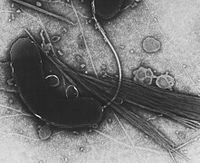
Photo from wikipedia
Vibrio parahaemolyticus is a gram-negative bacterium ubiquitous in seawater or estuarine water throughout the world. It is a major cause of seafood gastroenteritis complications. In this study, the presence of… Click to show full abstract
Vibrio parahaemolyticus is a gram-negative bacterium ubiquitous in seawater or estuarine water throughout the world. It is a major cause of seafood gastroenteritis complications. In this study, the presence of V. parahaemolyticus was investigated in 66 seawater samples collected during 2018 from 15 stations spread along the Tunisian coast using selective media including CHROMagar Vibrio media. The results show that only eight samples contained V. parahaemolyticus. However, while Vibrio alginolyticus was detected in all samples; both Vibrio cholerae and Vibrio vulnificus were not found. Nine of the presumed V. parahaemolyticus colonies were purified on tryptic soy agar from eight positive samples then identified by the API 20E biochemical test and confirmed by the presence of a specific target toxR gene. The detection of virulence genes, thermostable direct haemolysin (tdh) and thermostable-related haemolysin (trh), by the polymerase chain reaction (PCR) showed the presence of only two trh-positive isolates. The assessment of antibiotic susceptibility of the V. parahaemolyticus isolated revealed a complete resistance to colistin, amikacin, penicillin and cefotaxime and a total sensitivity to chloramphenicol, nitrofurantoin and sulfamethoxazole-trimethoprim with a multiple antibiotic resistance index (MAR) ranging from 0.4 to 0.5.
Journal Title: Journal of water and health
Year Published: 2022
Link to full text (if available)
Share on Social Media: Sign Up to like & get
recommendations!